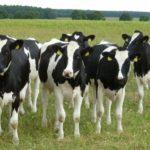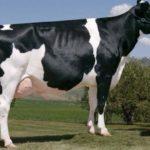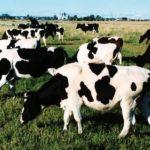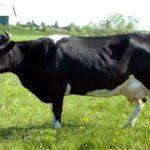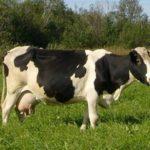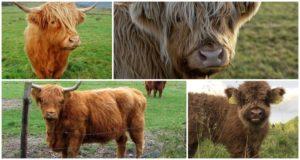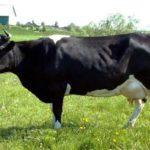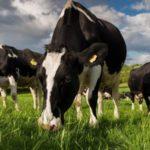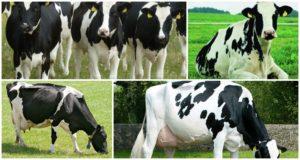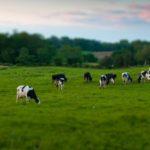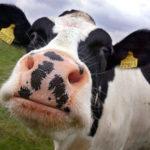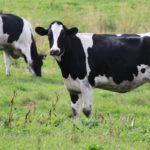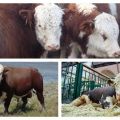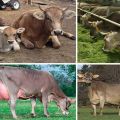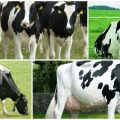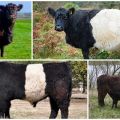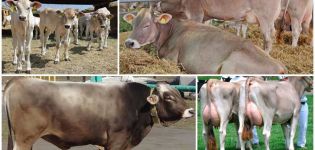Signs of the breed and characteristics of Kholmogory cows, pros and cons
In Russia, one of the oldest breeds of cows is Kholmogorskaya. Business executives appreciate this species for its high milk yield and disease resistance even in the cold climate of the northern regions of the country. But the conditions for keeping cattle have their own characteristics. Novice farmers should understand the nuances of caring for livestock before breeding animals.
Content
- 1 History and distribution of the breed
- 2 Attempts at selection of the 20th century
- 3 Description and productivity of the Kholmogory breed
- 4 Advantages and disadvantages
- 5 Rules for keeping and caring for animals
- 6 Cow feeding
- 7 How the Kholmogory breed is bred
- 8 Frequent diseases and methods of preventing them
- 9 What you need to know before buying
History and distribution of the breed
The breed was created in the 17th century. The name comes from the hilly area of the Arkhangelsk province. During the reign of Peter I, relations with Europe were actively developing. The construction of a port on the Northern Dvina opened up an opportunity for trade with other states. The inhabitants of the region were able to purchase cattle, which were imported by foreign ships. The breeding bulls were then crossed with local animals.
The Dutch have significantly improved the performance of Kholmogory cows, the exterior of the animals has also changed. In different areas, their own varieties of the breed were bred:
- Central - in central Russia.
- North - near Arkhangelsk.
- Pechora - in the Komi Republic.
The Kholmogory cows are most popular in the north of the country. The breed was officially registered in the 19th century. And today it accounts for almost 9% of the total number of livestock in the country. Farms of 24 regions of Russia are engaged in animal breeding.
Attempts at selection of the 20th century
In 1934, a breeding plant for breeding Kholmogory cows was opened in Russia, and the selection work continued. Scientists crossed animals with East Frisian bulls to further increase milk yield. Attempts have led to the opposite result. Milk productivity has decreased, the appearance of the livestock has not changed.
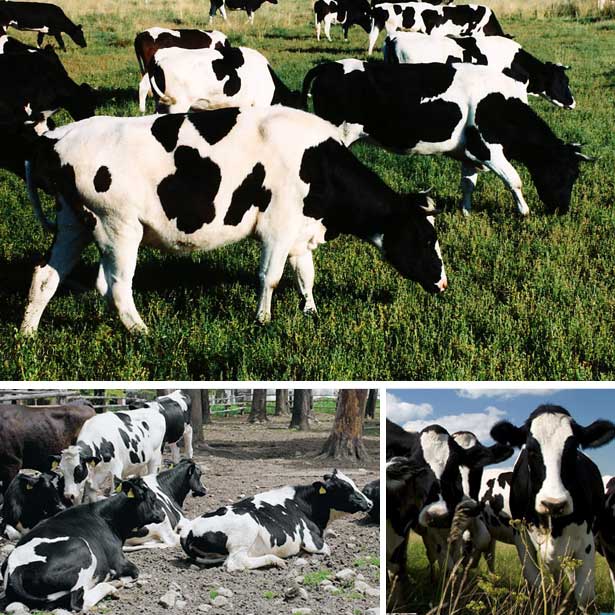
Experiments on improving the breed continued at the end of the century. Were even bred 2 new subtypes - Istoben cows and Tagil cows. Breeders are trying to change the appearance of animals, to increase the rate of milk delivery and its fat content.
Description and productivity of the Kholmogory breed
The purpose of animal breeding is to obtain milk and meat. Bulls are also used as producers.Kholmogory cows have developed all directions. Distinctive external features of the breed:
- The large body is angular, slightly elongated.
- The chest is broad and round.
- Smooth forelegs and slightly crooked hindquarters.
- Large, bowl-shaped udder.
- The suit is black and white. Sometimes there are plain specimens and very rarely - red-and-white.
- Sticking forward, rounded horns.
Animal weight:
| Age characteristics | Weight, kg |
| Calves: | |
| Newborns | 35-40 |
| 6 months old | 200 |
| Milch cow | 500-600 |
| Adult bull | 850-1000 |
During lactation, a cow gives up to 5 thousand liters of milk. Comfortable living conditions, careful care and careful attitude increase milk yield up to 6, and sometimes 10, thousand liters. The average fat content of the drink is 3.7%, the protein content is about the same. The first calving takes place at the age of 2.5 years. In cold climates, the productivity indicators of Kholmogory people are high. The breed is poorly adapted to hot weather.
Therefore, in the north, cows live up to 25 years. The southern species have a shorter life span - up to 15 years.
Advantages and disadvantages
The harsh conditions influenced the formation of the Kholmogory cows. This cattle breed has both positive and negative sides:
The main advantage of Kholmogory cows is the ability to show high milk yield in cold climates. Other breeds in harsh conditions do not differ in meat and dairy productivity.
Rules for keeping and caring for animals
Representatives of the Kholmogory breed of cows tolerate low air temperatures well, but suffer from extreme heat. Therefore, the room for keeping cattle is not required to be additionally heated. When arranging, take into account the recommendations:
- The barn area is calculated from a ratio of 6 square meters per cow.
- The building is erected with an attic or the roof is insulated.
- Provide an outdoor enclosure for walking animals. A canopy will protect the flock from rain or sun.
- A separate zone is allocated for milking.
- Feeders are arranged collectively, with free access.
- A concrete floor with slopes makes cleaning the barn easier.
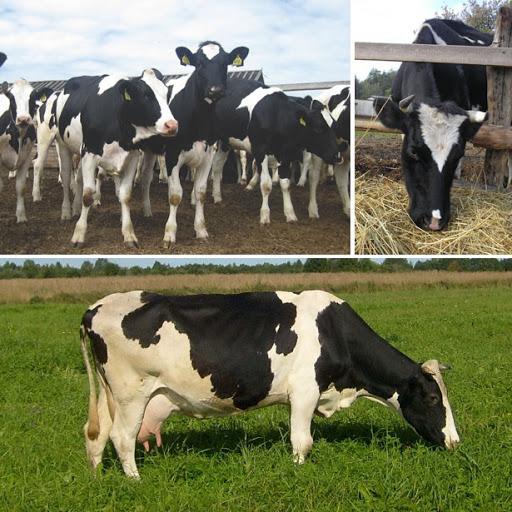
The conditions for keeping adult animals have their own characteristics:
- Lighting affects the milk yield. Under artificial lighting, cows produce less milk. Therefore, it is advisable to install large windows in the room.
- During the construction of a building, an effective ventilation system is considered.
- The straw bedding is changed 2 times a year, but fresh hay is constantly added.
When caring for young animals, specific rules are also observed. When cows are kept free, newborns are left with the mother. The calves are transferred to a separate room after about 2 weeks. It is optimal to arrange an individual box for each kid.
Cow feeding
The diet of Kholmogory cows depends on the season. In summer, animals eat pasture. The basis is green vegetation, supplemented by vegetables and fruits. In winter, they switch to hay, compound feed and root crops. It is helpful to include vitamin-fortified formulas in your food. The amount of milk produced directly depends on the nutrition. A poor diet does not promote milk production.
An adult animal eats per day:
| Name of feed | Food weight |
| Hay | 30 Kg |
| Combined feed | 15 Kg |
| Root vegetables (potatoes) | 10 Kg |
| Vegetables (the most common are beets and carrots) | 10 Kg |
| Salt | 5 g |
Additional dietary guidelines:
- Excessive consumption of vegetables by pregnant cows contributes to rapid weight gain and leads to problems during calving.
- Oil cake supplements increase milk yield, but are undesirable for inclusion in the diet of pregnant animals.
- Drink plenty of fluids in summer to keep you hydrated. In hot weather, the water should not be colder than the air. In winter, the liquid is heated.
When feeding Kholmogory, it is important to follow the diet, to ensure that the same intervals between eating and milking are observed.
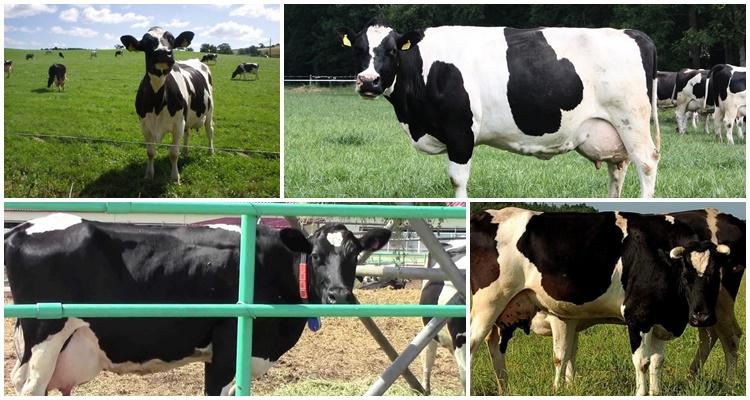
Newborn calves feed on mother's milk. After a month, they are given boiled vegetables and a small amount of concentrates, and then dry food. During this period, it is useful to include herbal decoctions in the diet. The young grow to root crops by the age of 2 months.
How the Kholmogory breed is bred
Breeding of Kholmogory cows does not require special conditions. The breed is very popular in the Arkhangelsk region. Farmers pay special attention to the development of the dairy sector. For this, different technologies are used:
- Emphasis is placed on cattle Holsteinization. This leads to an increase in milk yield, but the number of lactations decreases.
- Purebred cows give little milk, but often.
Animals are ready for the first mating after the first year of life. During the reproductive period, cows bring up to 15 calves. The weight of newborns reaches 40 kilograms. The offspring adapts well to external conditions.
Frequent diseases and methods of preventing them
Kholmogory cows are almost not susceptible to infectious diseases. Respiratory pathology, rheumatism or tuberculosis are also rare. And even when leukemia is detected, the animal remains productive. No cases of human infection have been registered, so milk can be eaten.
Cold climate resistance does not save cows from mastitis. To prevent udder inflammation, straw mats are used to keep animals in winter. And already at an early age, they must be vaccinated against rabies.
Most often Kholmogory suffer from diseases of the musculoskeletal system. This is influenced by the large weight of the animals. Inflammation of the hoof joint is especially characteristic of the Pechersk variety of the breed. Compresses are used as first aid. The cows are provided with a clean bed and complete rest. If necessary, a course of antibiotics is prescribed, and in order to restore strength, vitamin complexes are prescribed.
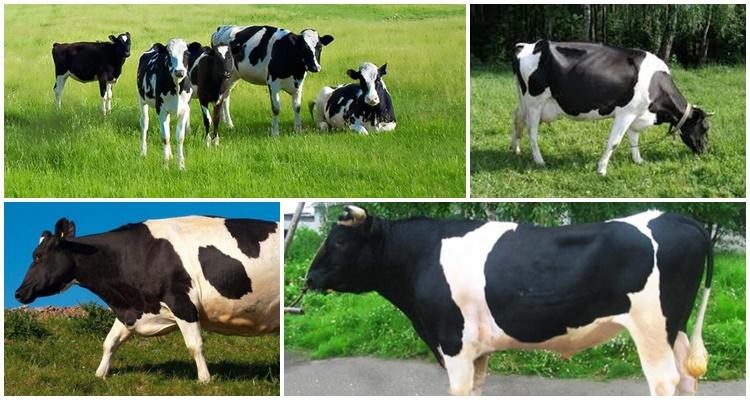
What you need to know before buying
Kholmogory cows are inexpensive. The breed was bred in Russia, and therefore the animals are common in many regions. The average price is 150 rubles per kilogram of live weight. Before buying cattle, there are a few tips to remember:
- It is better to choose individuals under the age of 5 years.
- Thoroughly check the skin, horns, pay attention to the udder, as well as the condition of the teeth, joints and hooves. A healthy animal is distinguished by energetic behavior and a clear look.
Experts believe that the best option is to purchase a cow that has had 2 or 3 calves. At this age, females show high milk production. Too young individuals are wayward, it will take a lot of effort to accustom them to milking.
The Kholmogory breed of cows has more advantages than disadvantages. But even for the most unpretentious animals, it is required to create normal conditions of detention. Balanced nutrition, adherence to the regime and proper care will ensure high productivity and will be the key to a long life for animals.
